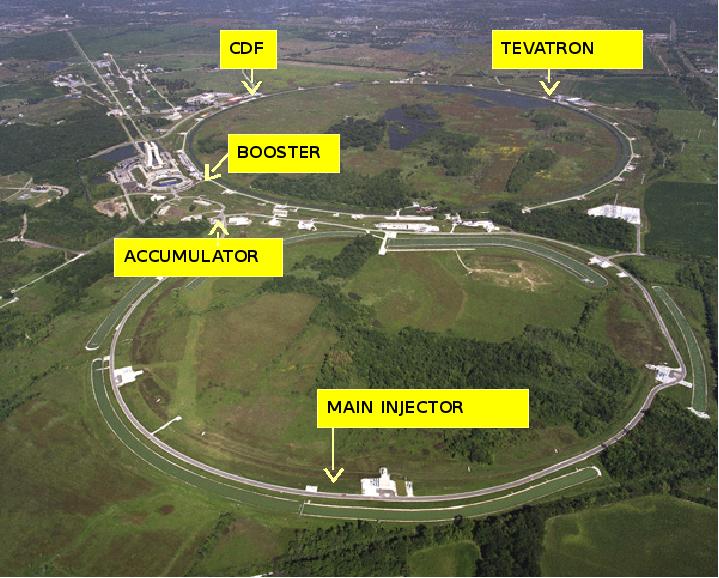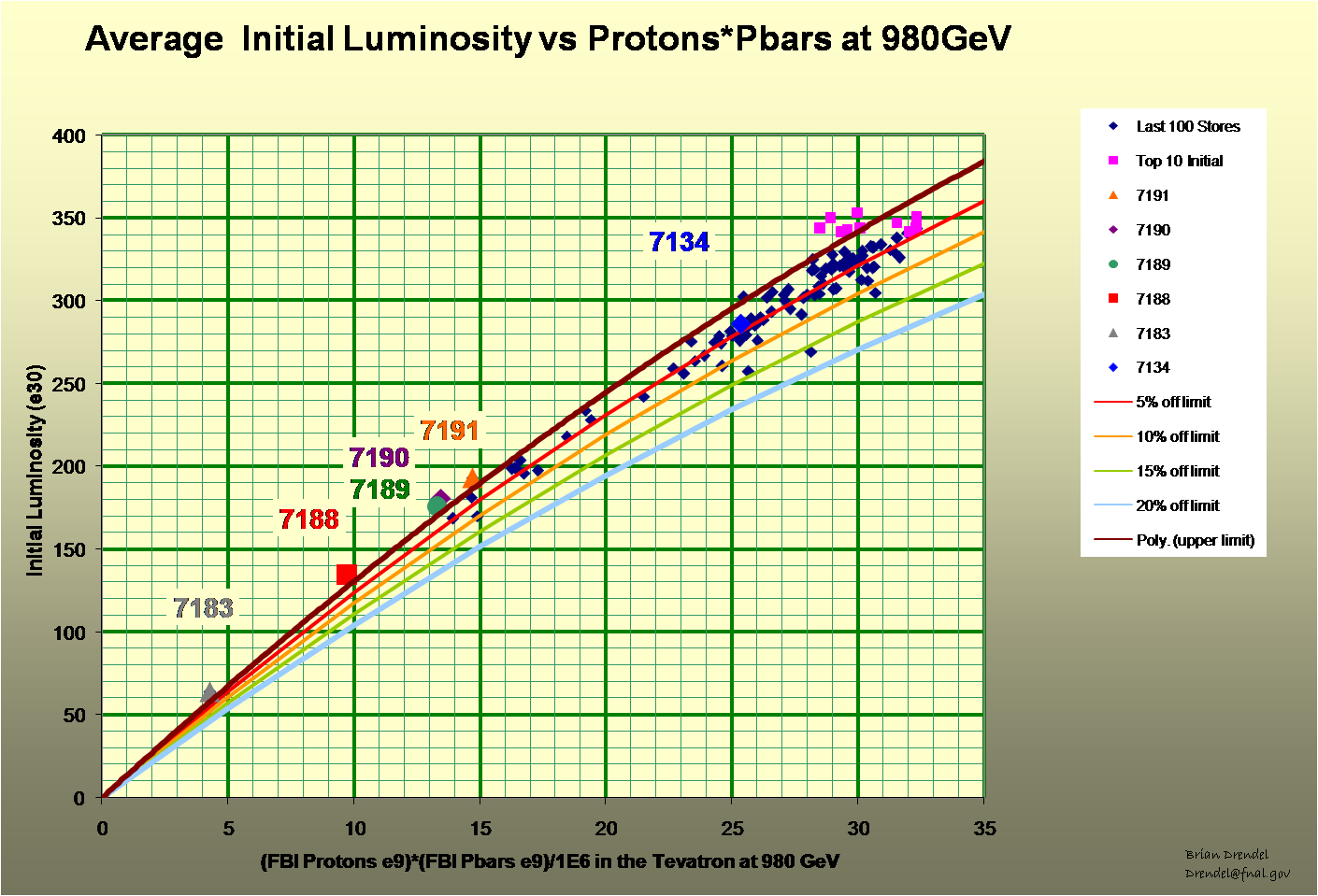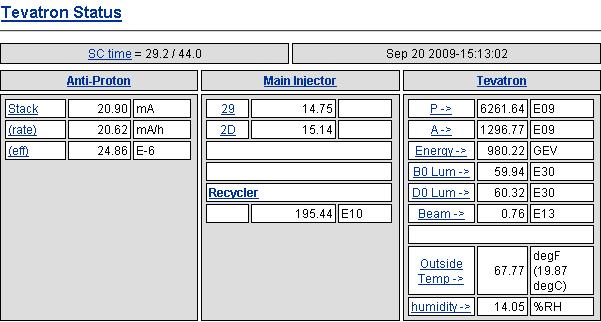A short introduction
For those of you who need a short introduction on the matter, I offer below a few paragraphs on the CDF experiment, Fermilab, and the Tevatron collider below. Of course, much more information is available from the web sites of these facilities (follow above links), or by just sorting through a number of articles I have written on these topics here or in my former blog.
CDF is a detector that records the outcome of high-energy collision of protons and antiprotons to study the creation of new states of matter, and investigate the physics of the smallest distance scales. Built in the early eighties, and upgraded several times to endow it with cutting-edge technology, CDF has discovered the long-sought top quark in 1994-95, measured for the first time the oscillations of B_s mesons in 2005, and also discovered a number of new composite particles -B baryons, the B_c meson, etcetera. More than 400 scientific papers of the highest quality, often announcing world's best measurements, have been published since the early eighties. If we exclude the "pitch drop experiment", CDF is the longest-lasting physics experiment ever run.
The detector sits underground in a cavern traversed by a circular 6.3 km long tunnel dug under the prairie at Fermilab, a laboratory located 30 miles west of Chicago. The tunnel hosts a particle accelerator, the Tevatron, which is capable of accelerating protons and antiprotons in opposite directions along its circumference, and bring them to collide at the highest energy so far achieved in man-made particle interactions, 2 Tera-electronvolts.
The Tevatron is not the only accelerator at Fermilab: before particles get injected inside the Tevatron ring, they have to be produced, accumulated, and transferred through a series of other machines. In the aerial picture below you can see that the Tevatron ring is in fact flanked by an oval almost as large, the Main Injector. Other machines cannot be made out by a bird's eye view, but they are all essential to the functioning of the whole system.

By studying the most energetic collisions between protons and antiprotons the CDF experiment (and its brother DZERO, which sits on the opposite side of the ring) hopes to gain access to new phenomena, which might deepen our understanding of subnuclear physics as well as the universe. But we not only need high energy to search for those new phenomena: the challenge is to collect as much data as possible, because the most interesting collisions are also the most rare.
A parameter enshrines the capability of a collider to produce more data: it is called "instantaneous luminosity", and it can be roughly described as the product of the number of protons and antiprotons circulating in the beam every second, divided by the size of the region where they are brought to intersect. Since the Tevatron orbits billions of particles at the speed of light, and squeezes them along micrometric paths, instantaneous luminosity is a very big number when expressed in macroscopic units, centimeters and seconds: the record luminosity ever achieved at a collider for protons and antiprotons is now
The units of inverse area and time are confusing, but they are not meant to be so: luminosity is actually an easy number to handle. Particle physicists measure the chance of a physical reaction between protons and antiprotons in units of area, and give it the name of "cross section". Cross sections can thus be measured in square centimeters -another slightly confusing habit. But when we multiply luminosity by cross section we magically get absolute rates in events per second!
The formula is simply N = s L, where s is the cross section and L the luminosity. N is very large if it describes the total rate of collisions: it can be of up to thirty millions per second at the Tevatron. However, if we want to produce a Higgs boson (let us assume it exists, and it has a mass of 120 GeV), then N is as small as a tenth of a thousandth, or even less: just one event per hour might be produced in the core of CDF, when the Tevatron runs at its best.
The CDF and DZERO detectors are on a race to collect as many collisions as possible, to have a chance of discovering the Higgs boson before the Large Hadron Collider at CERN will enter the game. LHC will run at a 5 to 7 times higher energy when it starts, and is designed to reach a hundred-times-higher luminosity than the Tevatron: once LHC gets to full speed, the Tevatron will be hard-pressed to justify its existence from a scientific standpoint. But the time for full LHC performances has not come yet, and it seems still tucked in a distant future.
How is the Tevatron doing lately ?
The Tevatron is emerging from a shutdown -a period during which servicing, repairs, and additions are performed- and putting good beam in the machine, to deliver data to CDF and DZERO, is harder after a restart. The accelerator experts in charge of Tevatron operations "ramp up" the performances after a shutdown, and they gradually achieve optimal running conditions after a few weeks. I am not an expert on accelerator physics, but I believe that one of the reasons for this incremental approach is that the accelerator is an extremely complex system, and finding the right beam parameters to run at the highest luminosity from scratch is nearly impossible: the safest way to get there is by successive approximations.
One way to check the performance of the machine is to look at the characteristics of recent stores (a "store" is the period during which collisions are produced; typical stores last 10 to 20 hours). In particular, a plot of the instantaneous luminosity at start of store versus the product of proton and antiproton beam intensities in the machine is a good way to figure out whether the particles are being used effectively. This is shown below.

The figure shows the last few stores (labeled 7183 through 7191) compared to older ones (scattered blue points) and the best 10 stores ever achieved by the machine (the pink squares on the top right). Curves of different colours show the trend between luminosity and number of protons and antiprotons, and describe optimal and sub-optimal conditions. You immediately see that the Tevatron has been doing extremely well recently, given the small number of protons and antiprotons it has used for the last few stores: the progression towards higher luminosity is closely following the optimal line.
Not everything shines, however. Store 7191, the one that started yesterday evening shortly after I began my shift, was unfortunately dropped at 9PM because of a magnet quench. A new store was soon put in the machine, but the lost antiprotons cannot be recovered: they need to be produced from scratch.
Antiprotons are the antimatter counterpart of protons. They do not exist in nature, and in order to produce them one must collide protons against a target, and sort through the debris that emerges downstream. The production of antiprotons is not very common in high-energy collisions, because of a rule strictly followed by strong interactions: the total number of protons minus the total number of antiprotons present before a collision remains the same (I am neglecting other baryons here, to simplify matters). This conservation law implies that if I strike a proton with another, in order to produce an antiproton I will have to also produce a proton ex novo, such as in
The most professional way to follow the status of the Tevatron is to directly peek inside the electronic log-book of the main control room, which contains up-to-the-minute information. This information is free to access, but it is impervious to non-experts due to the technical language used. A screen-shot of the Tevatron status can instead be obtained here. If you click that link, you should see something like in the picture below.

In the table you can read lots of information on the status of the machine. First of all, the number of antiprotons collected is shown in the first number on the top left, "Stack". It is given in milliAmperes, as if it were an electrical current. Of course: antiprotons are electrically charged, and when they are made to run around at speed of light, they do produce a current. Below the Stack you see the accumulation rate, in milliAmps per hour. Still below, you can read off the efficiency to collect an antiproton, per colliding proton -that is the number in the range of 20-30 per million, as I discussed above. On the bottom of the central panel, you also see how many antiprotons are stored in the Recycler ring: about two trillions of them, when I took the snapshot.
As far as the Tevatron is concerned, its status is described in the right panel. First is the number of protons (P) and antiprotons (A) circulating in the machine. Then the energy of the beam, in GeV -980, which is almost one TeV. Then, the instantaneous luminosity as is measured by CDF (B0 Lum) and DZERO (D0 Lum), in
However, the above information is maybe still too technical for you. In that case, a great way to keep updated with the Tevatron's fortunes, which is instead at reach for everybody who is curious about accelerator physics, is to become a fan of the Tevatron on Facebook. Not only do you then get updates from the machine, but you get to comment and interact with the many followers. So what are you waiting for ? Please join us and double the fun!
PS: if you want to have a look at the CDF Control Room in real time, just log on to skype and find me as "tonno923": I will give you a virtual tour!



Comments